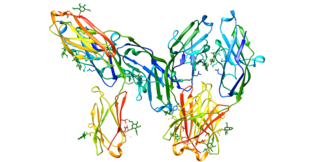Siglecs(Sialic acid-binding immunoglobulin-type lectins) are cell surface proteins that bind sialic acid. They are found primarily on the surface of immune cells and are a subset of the I-type lectins. There are 14 different mammalian Siglecs, providing an array of different functions based on cell surface receptor-ligand interactions.

CD22, or cluster of differentiation-22, is a molecule belonging to the SIGLEC family of lectins. It is found on the surface of mature B cells and to a lesser extent on some immature B cells. Generally speaking, CD22 is a regulatory molecule that prevents the overactivation of the immune system and the development of autoimmune diseases.

Sialoadhesin is a cell adhesion molecule found on the surface of macrophages. It is found in especially high amounts on macrophages of the spleen, liver, lymph node, bone marrow, colon, and lungs. Also, in patients with rheumatoid arthritis, the protein has been found in great amounts on macrophages of the affected tissues. It is defined as an I-type lectin, since it contains 17 immunoglobulin (Ig) domains, and thus also belongs to the immunoglobulin superfamily (IgSF). Sialoadhesin binds to certain molecules called sialic acids. During this binding process a salt bridge (protein) is formed between a highly conserved arginine residue and the carboxylate group of the sialic acid. Since sialoadhesin binds sialic acids with its N-terminal IgV-domain, it is also a member of the SIGLEC family. Alternate names for sialoadhesin include siglec-1 and CD169.

CD33 or Siglec-3 is a transmembrane receptor expressed on cells of myeloid lineage. It is usually considered myeloid-specific, but it can also be found on some lymphoid cells.

Acyl-CoA-binding protein in humans belongs to the family of Acyl-CoA-binding proteins.

Protein ERGIC-53 also known as ER-Golgi intermediate compartment 53 kDa protein or lectin mannose-binding 1 is a protein that in humans is encoded by the LMAN1 gene.

60S ribosomal protein L7a is a protein that in humans is encoded by the RPL7A gene.

Kallikrein-related peptidase 4 is a protein which in humans is encoded by the KLK4 gene.

Annexin A7 is a protein that in humans is encoded by the ANXA7 gene.

N-acylglucosamine 2-epimerase is an enzyme that in humans is encoded by the RENBP gene.

Sialic acid-binding Ig-like lectin 7 is a protein that in humans is encoded by the SIGLEC7 gene. SIGLEC7 has also been designated as CD328.

Sialic acid-binding Ig-like lectin 12, or Siglec-XII, is a protein that in humans, is encoded by the SIGLEC12 gene.

Nucleobindin-1 (NUCB1), also known as calnuc, is a protein that in humans is encoded by the NUCB1 gene.

Dynein light chain roadblock-type 1 is a protein that in humans is encoded by the DYNLRB1 gene.

Sialic acid-binding Ig-like lectin 9 is a protein that in humans is encoded by the SIGLEC9 gene.

Zinc finger protein 655 is a protein that in humans is encoded by the ZNF655 gene.

Sialic acid-binding Ig-like lectin 8 is a protein that in humans is encoded by the SIGLEC8 gene. This gene is located on chromosome 19q13.4, about 330 kb downstream of the SIGLEC9 gene. Within the siglec family of transmembrane proteins, Siglec-8 belongs to the CD33-related siglec subfamily, a subfamily that has undergone rapid evolution.

Sialic acid-binding Ig-like lectin 10 is a protein that in humans is encoded by the SIGLEC10 gene. Siglec-G is often referred to as the murine paralog of human Siglec-10
Lirentelimab is a humanized nonfucosylated monoclonal antibody that targets sialic acid-binding Ig-like lectin 8 (SIGLEC8). In a randomized clinical trial, lirentelimab was found to improve eosinophil counts and symptoms in individuals with eosinophilic gastritis and duodenitis. Adverse reactions include infusion reactions, which are mild to moderate and typically occur following the first infusion.

Sialic acid-binding Ig-like lectin 6 is a protein that in humans is encoded by the SIGLEC6 gene. The gene was originally named CD33L (CD33-like) due to similarities between these genes but later became known as OB-BP1 due to its ability to bind to this factor and, finally, SIGLEC6 as the sixth member of the SIGLEC family of receptors to be identified. The protein has also been given the CD designation CD327.

















